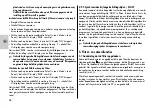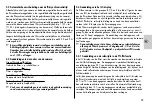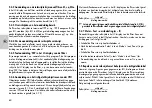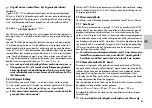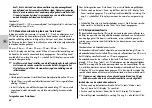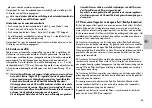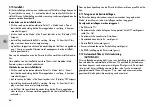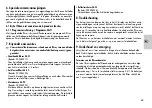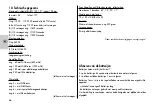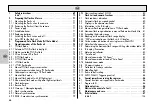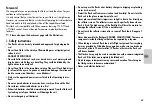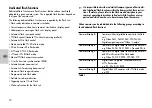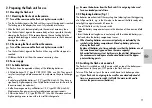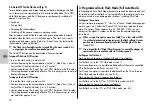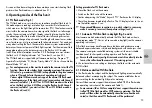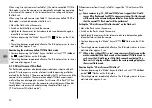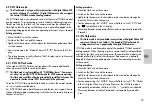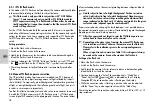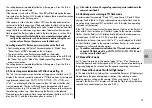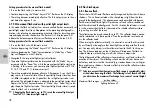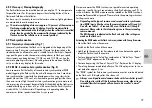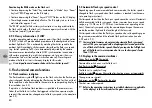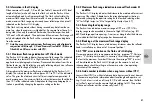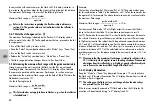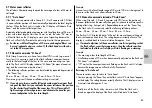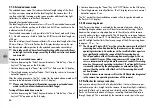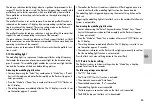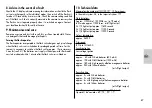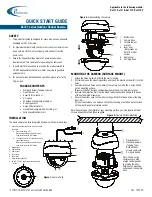
72
ķ
2.4 Auto-OFF for the flash unit (Fig. 2)
To save battery power and prevent inadvertent battery discharge, the flash
unit is factory-set to automatically switch-over to standby mode (Auto-OFF),
while flash readiness and the LC display are simultaneously switched off,
approx. 3 minutes after:
• Switch-on
• Firing a flash
• Actuating the shutter release
• Switching off the camera’s exposure metering system.
After automatic switch-off the last-used settings are retained and instantly
available when the flash unit is switched on again. The flash unit is reacti-
vated merely by depressing the „Mode“ or „Zoom“ key or by touching the
shutter release (wake-up function).
The flash unit should always be turned off by the main switch if it is
not going to be used for an extended period!
The Auto-OFF function can be deactivated whenever required:
Turning off the Auto-OFF function
• Turn on the flash unit by its main switch.
• Continue depressing the key combination „Select“ (= „Mode“ key + „Zoom“
key) until the LC display indicates „3m“ (= 3 minutes).
• Continue depressing the „Zoom“ key until „OFF“ flashes on the LC display.
• The setting becomes immediately effective. The LC display returns to normal
display after approx. 5 sec.
Turning on the Auto-OFF function
• Turn on the flash unit by its main switch.
• Continue depressing the key combination „Select“ (= „Mode“ key + „Zoom“
key) until the LC display indicates „3m“ (= 3 minutes).
• Continue depressing the „Zoom“ key until „ON“ flashes on the LC display.
• The setting becomes immediately effective. The LC display returns to its nor-
mal state after approx. 5 sec.
☞
3. Programmed Auto Flash Mode (Full Auto Mode)
In Programmed Auto Flash Mode the camera controls the aperture and shut-
ter speed, as well as the flash unit, automatically so that optimal results are
always assured in most photographic situations, including fill-in flash.
Settings on the camera
Set your camera to program “P”, “Vari” or a “Scene” Mode (landscape, por-
traiture, sport, etc.). Select the “Single-AF (S)” auto-focus mode on the ca-
mera. On various Nikon cameras (e.g. F5, F65, F80, F100), you must
always set the highest f-number on the lens (see the camera’s operating
instructions).
When using a Group A camera (see Table 1) or a lens without CPU
(i.e. without electronic data transmission), the flash reflector’s zoom
position must be manually adjusted to the focal length of the lens
(see 5.7.2)!
Use a tripod for the “Night Shots Program” to avoid the danger of
camera shake in connection with slow shutter speeds!
Settings on the flash unit
Flash mode with cameras of Groups A, B and C (see Table 1):
Set the flash unit in the “TTL” flash mode (see 4.1).
For Group B cameras it is possible to additionally set the matrix-controlled
fill-in flash mode on the flash unit (see 4.1.2).
For Group C cameras it is possible to additionally set the 3D multi-sensor
fill–in flash mode on the flash unit (see 4.1.3).
Flash mode with Group D cameras (see Table 1):
Set the flash unit in the D-TTL or D-TTL 3D flash mode (see 4.2).
Flash mode with Group E cameras (see Table 1):
Set the flash unit in the i-TTL or i-TTL BL flash mode (see 4.3).
☞
☞
Summary of Contents for MECABLITZ 54 AF-1 N
Page 45: ...45 ĸ ...
Page 67: ...67 ń ...
Page 89: ...89 ķ ...
Page 111: ...111 ƴ ...
Page 141: ...141 ...

